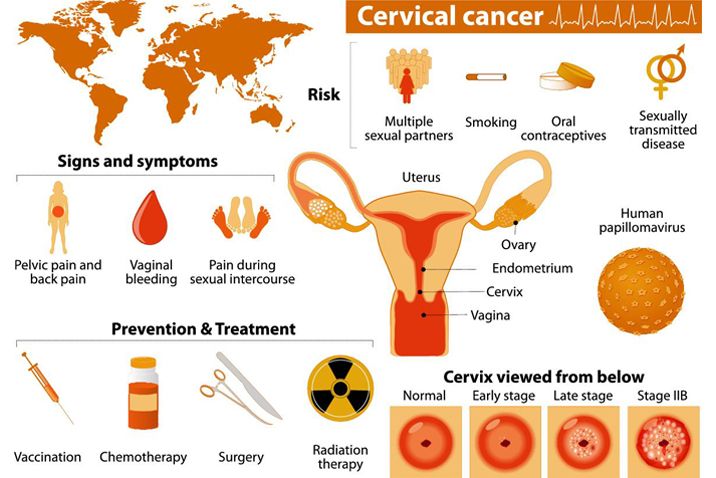Cervical cancer is a cancer that arise from the cervix. It is due to an abnormal growth of cells that have the ability to invade or spread to other parts of the body (the cervix is the lower, narrow part of the uterus or the womb). Almost all cases of cervical cancer are caused by the human papilloma virus (HPV) which can be passed on through any type of sexual contact.
Factors increasing the risk of contracting cervical cancer include smoking, immunosuppresion, early sexual debut, having multiple sexual partners as well as the use of hormonal contraceptives. Studies have shown that smokers keep HPV infections longer and are less likely to clear them, when compared to women who have never smoked. Several reports suggest that women whose immune systems are weakened are more likely than others to develop cervical cancer. Women who are HIV positive are at increased risk of developing cervical cancer.
It is important for women to report to their nearest health facilities when they notice signs and symptoms such as increased menstrual bleeding, abnormal vaginal discharge, bleeding between periods, pain during sexual intercourse, lower back pain, bleeding after sexual intercourse and any vaginal bleeding (for women on menopause).
According to the HPV Center, 2017, cervical cancer ranks as the most frequent cancer in women in, Malawi, Kenya, Zambia and Zimbabwe and the second most frequent cancer in women in South Africa. It is the most frequent cancer in women aged between 15 and 44 and the first leading cause of cancer deaths in women in the above mentioned countries.
This however is just a tip of the iceberg as many other cases go unreported especially in rural areas where the cost of treatment in unaffordable to many. Many women are unaware of how the condition presents itself owing to very few awareness campaigns on the condition.For the women who seek treatment, many of them report to health facilities with advanced cases where treatment does very little to save life. Cervical cancer treatment is mostly offered at centers that are out of the reach of many women, especially those living in marginalized areas.
In the vast majority of these resource poor settings, screening programs have proven to be difficult to reach with the lack of human and technical resources required. Many women have to travel long distances in order to access facilities with trained medical practitioners, drugs and equipment and are often turned away due to high volums of women seeking these services. The health systems are simply overwhelmed and as a result, women continue to suffer. In addition, stringent resources have made it difficult for governments to implement HPV vaccines, a move which will greatly degrease incidence (new cases) of the disease.
Despite these challenges, many governments in the affected countries have not integrated programs to address this problem into nation health programs yet cervical cancer can be treated if detected early. It is heartbreaking that women have to go through severe pain when the untreated cervical cancer spreads to other parts of the body. Cervical cancer may spread into nerve endings, bones or muscles, causing excruciating pain. Another distressing sign of advanced cervivcal cancer is an unpleasant-smelling discharge from the vagina arising from reasons such as breakdown of tissue, the leakage of bladder or bowel contents out of the vagina, or a bacterial infection of the vagina. All this can be prevented if we all come together to fight cervical cancer.
It is important to note that as women, we can prevent infection through the use of condoms, both male and female correctly and consistently during sexual activity, screening every three years for HIV negative women and once every year for HIV positive women as well as encouraging our young girls to delay sexual activity.




